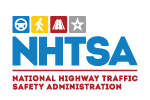Metric Development:
To determine when and if a driver is performing safely an objective means to evaluate driver behavior (a metric) needs to be developed. NHTSA is engaged in efforts to be able to measure driver workload, performance and driver distraction. A better understanding of drivers’ capacities can lead to systems that are in line with their capabilities.
Driver Workload Metrics:
Today's drivers often deal with an onslaught of information that can divert their attention from their primary task of driving. Although some in-vehicle technologies are intended to improve safety, the use of multiple devices may distract the driver and actually jeopardize safety. When multi-tasking, drivers divert their attention from the road to glance at displays, operate controls, or listen and speak to a voice interface. These reports are the result of a cooperative study with industry to develop techniques to objectively evaluate the attentional demands of operating in-vehicle devices on various aspects of driver performance.
- L. Angell, J. Auflick, P.A. Austria, D. Kochhar, L. Tijerina, W. Biever, T. Diptiman, J. Hogsett, and S. Kiger (CAMP) (2006) Driver Workload Metrics Project: Final Report. DOT HS 810 635
- L. Angell, J. Auflick, P.A. Austria, D. Kochhar, L. Tijerina, W. Biever, T. Diptiman, J. Hogsett, and S. Kiger (CAMP) (2006). Driver Workload Metrics Project: Final Report - Appendices. DOT HS 810 635
Crash Warning Interface Metrics:
Advanced Crash Warning Technologies (ACWT) have the potential to improve safety by preventing crashes and mitigating their impacts by warning drivers of the need for corrective action. However, the question remains as to whether ACWT will produce the anticipated significant safety improvements. If the system is not designed to be compatible with driver capabilities, drivers may not fully understand or react appropriately to the crash alerts. It is also possible that their use will introduce unforeseen or unintended consequences, particularly if drivers do not understand how the system works Therefore, it is important to develop a set of test protocols and metrics to evaluate the relation of ACWT design to driver performance and behavior. The goal of this project is to derive such metrics.
